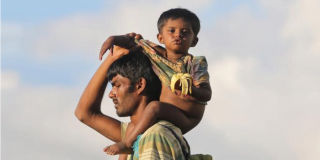With Parliament set to resume debate on asylum seekers it is worthwhile reminding ourselves of some simple facts. These are drawn from an August 2011 report by the Centre for Policy Development titled A New Approach. Breaking the Stalemate on Refugees and Asylum Seekers. One of the authors, John Menadue, was Secretary of the Department of Immigration during the Fraser Government.
1. Australia has a proud history with regard to refugees. Not only are we one of a handful of countries that have a standing policy to receive a quota of refugees each year, we have successfully received over 700,000 refugees since the end of WW2, and we played a key role in establishing the Convention that guides the international response to refugees. As the sixth nation to sign on, it was our agreement that made the Convention an internationally binding treaty;
2. A refugee is not someone who decides to emigrate to a more desirable country. A refugee is someone who “owing to well-founded fear of being persecuted for reasons of race, religion, nationality, membership of a particular social group or political opinion, is outside the country of his nationality and is unable or, owing to such fear, is unwilling to avail himself of the protection of that country.” (Refugee Convention) Refugees are people who have experienced traumatic events and need out empathy, care and protection;
3. Australia bears only a small proportion of the world’s refugee burden. Most refugees flee to and remain in a neighbouring country where they feel some cultural connection and can return home if the situation improves. As a result, of the 10.6 million refugees in the world, 80% are found in developing countries. Pakistan, with 1.9 million, is home to the most. In our region China is home to 300,000; Nepal to 90,000; Thailand to 97,000; Malaysia to 86,000. Australia is home to 22,000. (2010 figures). Even of those countries who receive applications for asylum Australia bears a small burden. In 2009 the Nordic countries of Denmark, Sweden, Norway, Finland and Iceland, with a combined population of 25 million (roughly equivalent to Australia’s 22.5 million) received and processed 51,120 asylum claims. Australia received and processed 6,500;
4. Of the 10.6 million refugees in the world, resettlement in a third country is the only viable option for around 700,000. Yet only around 100,000 receive resettlement in any given year. Australia is one of a handful of countries that has nominated to resettle refugees who apply for asylum from another country, taking around 7,000 a year;
5. The flow of asylum seekers to affluent nations and the flow to Australia follow the same trend line. When numbers are high in the US, Canada, UK, etc they are high here. When numbers are low in the US, Canada, UK, etc they are low here. This suggests that domestic policies such as mandatory detention are not a significant deterrent.
In view of these facts the report recommends we reframe the debate on asylum seekers, accepting that as long as people are unsafe they will try to reach safe havens like Australia. We should then focus more on how we can protect them than on how we ‘protect our borders’. The authors recommend three things:
1. We work with other countries in the region to develop long term and sustainable mechanisms for receiving and resettling refugees;
2. We end mandatory detention. After health and criminal checks asylum seekers should live in our communities;
3. We raise our ‘offshore’ program to 20,000 refugees per year and decouple the ‘onshore’ and ‘offshore’ numbers. At the moment Australia receives around 13,500 people per year under its Special Humanitarian part of the immigration program, of which the majority are refugees, in refugee like situations or family members of refugees. This number includes any asylum seekers arriving by boat and plane who are found to be refugees. So if 5,000 arrive by boat or plane, this leaves only 8,500 places for asylum and other applicants from overseas. The report recommends 20,000 refugees be resettled each year from overseas camps regardless of how many come by boat. This would overcome any sense that boat and plane asylum seekers were taking the places that might otherwise go to offshore applicants, would allow us to be a bigger and fairer part of a global response to the refugee crisis and allow us to fulfil our obligations to receive and protect asylum seekers arriving on our shores and at our airports.
Eminently sensible, compassionate and just if you ask me.







good report rowena am thinking about doing asylum seekers for assignment for Debates in SS.
Great idea Corrina. There is such a lot of misinformation out in the community. Go for it!!